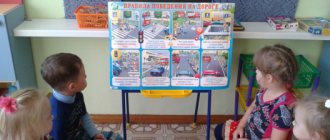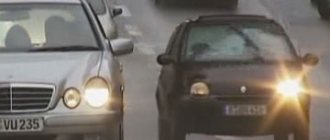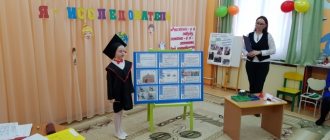Traffic rules Projects – Information and educational project “Safe Road Traffic” for children 5–7 years old
Publication “Information and educational project “Safe Road Traffic” ...” Project on traffic rules in the speech therapy group “Safe Road Traffic” Project type: informational and educational. Implementation time frame: long-term Project participants: children 5-7 years old, parents of pupils, teachers Relevance A serious problem in maintaining safe…
Socially significant project for children 6–7 years old “The ABC of Road Traffic” Passport of a socially significant project Project name: “The ABC of Road Traffic” Project type: socially significant Organization executing: MADOU MO Krasnodar “Center – Kindergarten No. 118” Project manager: teacher Dmitrieva Alvina Arkadyevna Project completion time: from...
Project on traffic rules for children of senior preschool age “My street is cheerful!” Department of Education of the Administration of the City District of Saransk MDOU "Kindergarten No. 112 of a combined type" Project on an innovative (experimental) direction of work of the teaching staff on the topic: "My cheerful street" Author - developer: teacher Amashaeva E. P....
Week-long pedagogical project “Road Safety” (senior preschool age) Kindergarten “Beryozka”, branch of the Kindergarten “Firefly” Organized educational activities Pedagogical project “Safety on the Road” (senior preschool age) Educator N.V. Peeva, teacher. Project duration: short-term (week. Project type…
Progress of the conversation:
Traffic lights were invented to regulate traffic safety on the streets. They became widespread after the invention of the automobile. Before that, there was no particular need for official traffic rules and traffic control devices: people relied more on common sense and correct behavior. But when the streets filled with fast and noisy cars, it became obvious that traffic regulation was necessary. Traffic lights, which forced some people to stop while others could move, were one way to protect cars and pedestrians from collisions and avoid traffic jams.
The first traffic light appeared in England in central London in 1868. This gas lantern, covered with red glass on one side and green glass on the other, was suspended from a high iron pole, and could be turned in one direction or the other by means of a handle mounted at its base. Of course, there were no cars at that time. But the number of steam-powered vehicles, animal-drawn carts, and pedestrians increased so much that traffic lights were needed to prevent accidents.
The electric traffic light was invented by Garrett Morgan, an African American inventor and businessman. After purchasing his first car, Morgan realized that some kind of traffic control was needed at intersections. He came up with a traffic light that worked on the same principle as the light signals installed at railway sidings . The first traffic lights had red and green lights, and when the light changed, an audible signal was heard. But as the traffic and associated noise increased, it became clear that the warning light that turned on between the "move"
and
“stand”
will be more effective than sound.
A yellow or orange signal has been added to traffic light signals to alert drivers that a stop
.
Conversation on the topic: “How to behave on the street”
Goal: to form in children an idea of safe behavior on the street.
Preparatory group. Senior preschool age. Children 6-7 years old
Project “Road ABC” in the preparatory group Municipal budgetary preschool educational institution of the Pushkin city district kindergarten No. 12 “Vasilyok”
Project Road ABC Type of project : informational and educational. Duration of the project : short-term 11.10-22.10.21 Project : pupils...
Methodological development “The best layout project for traffic rules” for children 5–6 years old
METHODOLOGICAL DEVELOPMENT: “THE BEST LAYOUT PROJECT ACCORDING TO TRAFFIC RULES ”
“A JOURNEY ALONG
THE “RIVER OF TIME”
FOR CHILDREN 5-6 YEARS OLD “FROM CARRIAGE TO CAR” EXPLANATORY NOTE A child is a rational being, he knows well the needs, difficulties and obstacles of his life. Not arbitrary orders, not...
Project "Children and the Road"
Game "Where is my place?"
Preparing for the game:
Construction of the road, placement of warnings on the road (school, cafeteria, road repair, etc.) corresponding to the studied traffic signs.
Rules of the game:
The players' task is to replace verbal warnings with the necessary signs.
The game can be played in two versions.
1. One player places the signs, the rest evaluate the correctness. 2. Two players compete to see who can place the signs faster and more correctly.
Game "Confusion".
Preparing for the game:
The teacher designs the road in advance and places the signs incorrectly (near the Zebra there is a “Slippery Road” sign, etc.).
Then he tells the children a story about how evil spirits decided to create chaos in the city; he asks for help to correct the situation. Rules of the game:
Children, having turned into good wizards, place the signs correctly. They explain what they are doing.
Game "Road Test".
Preparing for the game:
Construction of the road and placement of signs.
Rules of the game:
Child-driver-student passing the test for the right to drive a car. He “drives” along the road and, seeing this or that sign, explains what he must do. For example: there is a slippery road ahead. I slow down and drive carefully, not overtaking other cars.
Game "Guess the sign".
Preparing for the game:
All signs are placed at a distance from each other.
Rules of the game:
The teacher reads out a verbal description of what this or that sign means. Children must run to the right sign. Children who choose the sign correctly receive a token. At the end of the game, they count how many tokens they have and determine the winners.
Game “TRAVEL THROUGH THE CITY”
Program content:
introduce children to the rules of behavior on the street, in transport and in public places.
Progress of the game:
The teacher creates a game situation by introducing the fairy-tale character Pinocchio. He says that Pinocchio came to the children from another country - from Italy. He is a foreigner, he really likes it here and wants to know everything better. Today Pinocchio would like to go to the zoo to see the animals, but he does not know the way, does not know the rules of conduct in the zoo. Guys, let's help the guest. How many of you have already been to the zoo (the children say that they were not alone, but with their parents and therefore do not know the way). The teacher says: “It’s no problem, I’ll help you!” True, the trip will not be entirely real; we will travel using pictures and a layout. First, the teacher asks Pinocchio to explain what is shown in the pictures and, making sure that the children understand what will be discussed, begins the excursion.
Educator:
Imagine that the weather is sunny and beautiful, we held hands (Pinocchio will walk next to me) and left the kindergarten (shows the picture). First we went by bus to the station, then by train to Moscow. And here we are in Moscow. Cars are scurrying around. Which ones did you find out? (children name special transport they know). To get to the metro we have to take a special path for pedestrians. Who knows what it's called? (children's answer). The teacher asks to find a picture of a walking path and put it on a flannelgraph. That’s right, the pedestrian path is called a “sidewalk.” “What is the name of the road along which traffic moves?” Highway or roadway (if the children find it difficult to answer, the teacher names it himself, and the children repeat in chorus) - So we approached the metro. Please show me a picture of the subway. What is the name of the staircase that takes us underground (shows a picture). That's right, it's called an “escalator”. Next, the teacher asks the following questions: “Who controls the electric train? Who announces the stops? Who keeps order in the subway?
Project on traffic rules in the preparatory group “ TRAFFIC RULES ARE WORTHY OF RESPECT!”
Type of project: Informational - educational.
Implementation timeframe: short-term
Project participants: children, teachers, parents of students.
Relevance The problem of road safety is currently one of the most important urban problems. The population is growing, more and more people are purchasing cars for personal use. The number of road traffic accidents is increasing. Unfortunately, they also happen with the participation of preschool children. Often, a child does not understand the real danger that threatens him on the road, and therefore treats the Rules of the Road without due attention. Goal: To develop safe behavior skills in preschool children on the road, on the street and in transport. To reinforce children’s understanding that the rules prescribed for pedestrians, passengers and drivers must be clearly known and followed. Objectives: - deepen children’s understanding of the Rules of the Road, acquired earlier; -continue to acquaint children with the meaning of road signs, understand their schematic representation for correct orientation on the streets and roads; - to form in children basic knowledge about reflective elements. — develop in children a sense of responsibility in observing traffic rules; — develop caution, attentiveness, independence, responsibility and prudence on the road ; - develop memory, speech, logical thinking, attention. — to cultivate the moral qualities of an individual necessary for mastering and following traffic rules: attentiveness, observation, discipline; — develop skills of cultural behavior on the street and in public transport.
Stages of work: 1. Preparatory stage. - selection of methodological literature; - drawing up a long-term plan; - development of didactic material.
2. Main stage: - selection of material on traffic rules; - examination of drawings, photographs about road situations; - viewing of video material; - familiarization with fiction.
1. Conversations: “Road safety”; “What road signs do you encounter on the way to kindergarten”; “Responsibilities of a pedestrian”; “Attention, road signs !”; “Transport on city streets”; “Rules for passengers”;
2. Artistic creativity: drawing: “Create a new road sign.” sculpting: “Funny traffic light.” applique: “Road sign.”
3. Analysis of situations: “What would happen if there were no traffic ?”; “What if all the signs were mixed up?”
4.Reading fiction: S. Mikhalkov “Traffic Light”, “Bad History”, “My Street”; N. Kalinin “How the guys crossed the street”; A. Northern “Three wonderful colors”; P. V. Ivnev “How the street talks”, G. Yurmin “Curious little mouse”; N. Nosov "Car".
5. Making riddles, looking at illustrations “Road signs”, “Children and the road”, “Road safety”.
6. Viewing electronic presentations, cartoons: “Road Rules”; “In the Land of Road Signs”; “Smeshariki on the Road”; “Road Rules”.
7. Outdoor games: “Pedestrians and cars”, “Traffic officer”, “Stop - go”., “Be careful”;
8. Didactic games: “Road Lotto”; “Know and follow the traffic rules”; “Who can name the most road signs?”; “Traffic light”; “Find out by description.”
Working with parents:
Memos to parents: “Know and follow the traffic rules yourself. Be an example of discipline on the street for children"; "Why do we need reflectors on clothes." Booklets: "Causes of children's road traffic injuries."
Bibliography:
N. N. Avdeeva, O. L. Knyazeva, R. B. Sterkina.
“Safety”: A textbook on the basics of life safety for children of senior preschool ageN. N. Avdeeva, O. L. Knyazeva, R. B. Sterkina, M. D. Makhaneva “Safety on the streets and roads” Methodological manual for working with children of senior preschool age.” K. Yu. Belaya K. Yu. “Formation basic safety principles for preschoolers" Downloaded: 49 times



